Leica M Typ 240 Review
Leica M Typ 240 Review:
The Leica M, the M10 or the Typ 240 as some call it, is the most anticipated camera for me because I grew up with Leica rangefinders. My interest in Leica started around the age of twelve when my dad gave me an old M3. I don’t think he thought it would have had such a huge impact on me but it obviously did. I went absolutely everywhere with that camera, and I probably shot more with that camera over the years than I ever did with my M9. As the years went by, I dabbled in a bit of medium format. I bought a Mamiya 6, and then 6MF, which are both rangefinders but my heart always lied with Leica M cameras. The M3 left such a huge impression on me that I sold my Mamiya’s, and bought myself an M6TTL.
When the Leica M9 was announced back in 2009, I was so excited because a full frame digital M camera was finally being released. I held out so long, and I still remember almost coughing up the money for an M8.2 just a few months before the M9 was announced. But a little voice inside of my head kept telling me that Leica was going to come out with a full frame camera even though Leica themselves said it was impossible. Just wait. Just waiting is what I did, and I’m glad I listened to my inner voice. The M9 was so much better than I ever expected. It produced beautiful images even by today’s standard, and it wasn’t just compatible with almost every single M lens out there, each lens on the M9 seemed to produce it’s own unique signature. Most importantly, it was a true M. At the time, it was the perfect camera for me, and I’m pretty sure for many others as well.
My Leica story is just one of many stories out there concerning the red dot. Many people have great stories about inheriting Leica’s or travelling around the world with their trusty M. With this much pressure, it must be a nightmare for Leica to actually produce a new M camera :). In many ways, the M camera is similar to something as iconic as a Porsche 911. 911 fans generally don’t like major change but also want improvements in the next generation model. For instance, you’ll probably never hear of a front engine 911 because one of it’s famous attributes is that it’s a rear engine car. They admire the quirks that come with the car, and find them to be strengths.
So, when Leica announced the next generation M, it naturally brought on a lot of debate. Discussion got so heated that some already anticipated the new M to be a failure even before its release. But here at Finding Range, I believe in two things. First, you always have to give something a chance. The only way to experience a camera is to actually have it physically in your hands. Giving something a serious chance means that you have to try to let go of your biases, and fully commit to exploiting the abilities of both you as a photographer, and of the camera. Second, I said this before in a previous post, and I’ll say it again; I don’t believe that Leica would ever come out with an M that was inferior to its predecessor because it’s the company’s flagship model . I’m sure they do their research before replacing their most famous camera.
With that said, is the new Leica M a better camera than the M9? Does it still have the same purity we all value so much in an M? Can the new M live up to the M line? More importantly, is it a real M? These are just a few questions that I’m sure many people are asking, and I will try to answer in this review. But just to let you know…if you’re looking for reasons to not buy the new M, maybe you shouldn’t read any further because it has quickly become my favorite M.
Leica M Typ 240 Build Quality:
One main attribute of M cameras is that they’re extremely well built, and the Leica M is no exception. In fact, I believe that this camera is built to even higher standards than the M9. When I first picked up the new M, I remember thinking to myself, “Wow, now this is a real Leica M.” The fit, finish and the quality of materials are second to none. I always believed that Leica build quality was simply the best but Leica really went the extra mile with this new M. Leica didn’t just improve on the M9; they completely redesigned the new M. I just love picking up this thing because I still can’t get over how solid this camera feels! It has a really gratifying dense feeling to it, and it’s a bit heftier than the M9.
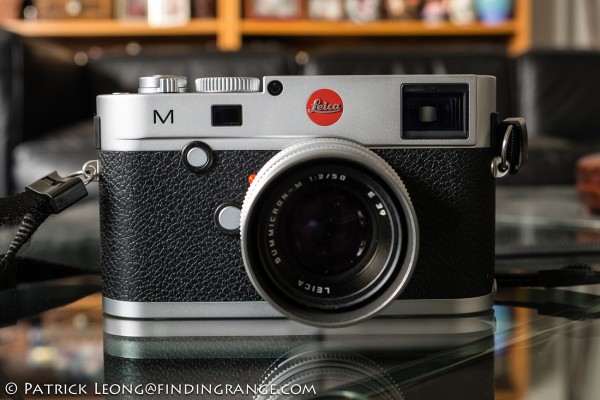
↑ Front view of the new Leica M Typ 240. I originally thought the M9/M9-P looked better but I actually prefer this look now.
I also feel that the Leica M is slightly better built than my film M’s. I don’t mean to upset any film people but that’s how it feels to me. It feels like one solid block of fine grade metal rather than individual pieces. This camera is just so refined now, and this is not the only area that we are going to experience this new found refinement.
Leica still uses the removable baseplate, which I’m glad they use for mostly nostalgic reasons. But it has been slightly redesigned. It now has rubber sealing because the new M is weather resistant. When you take the baseplate off, everything looks very neat, clean, and organized. The battery compartment is tight and sturdy. The tripod mount is now built into the camera, and it looks very beefy.
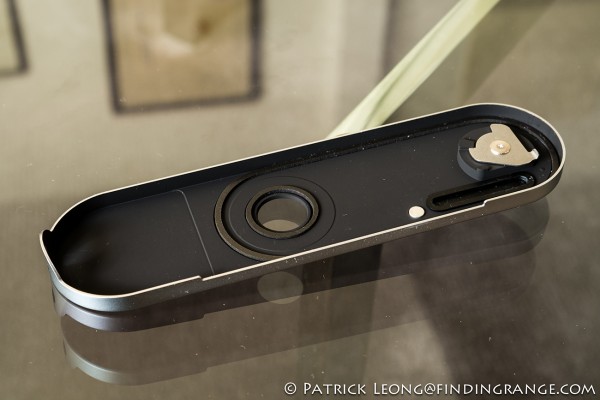
↑ The base plate from the new Leica M has changed a bit. For one, it has rubber seals because the new M is weather resistant. Also, as you can see from the photo, there is a whole for the tripod socket, which is now built into the camera.
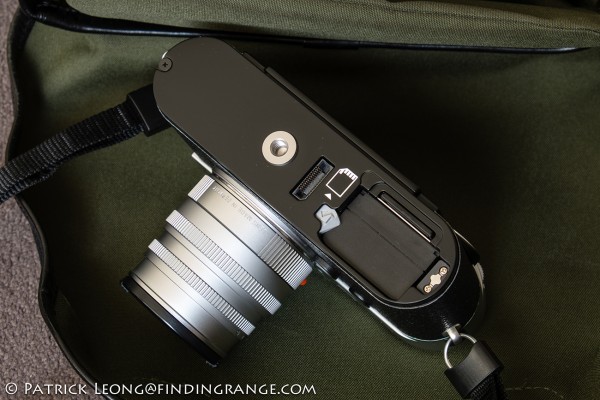
↑ The bottom of the Leica M with the baseplate taken off.
The buttons also have a nice feel to them, and the new metal scroll wheel feels more solid than the older one on the M9. Us Leicaphiles also finally get a decent 920k-dot 3 inch LCD screen with scratch resistant Corning “Gorilla” glass. In my opinion, this is a nice alternative to sapphire glass because, although it’s probably cheaper, it’s also pretty sturdy. It’s the same glass that they use on the Apple iPhone.
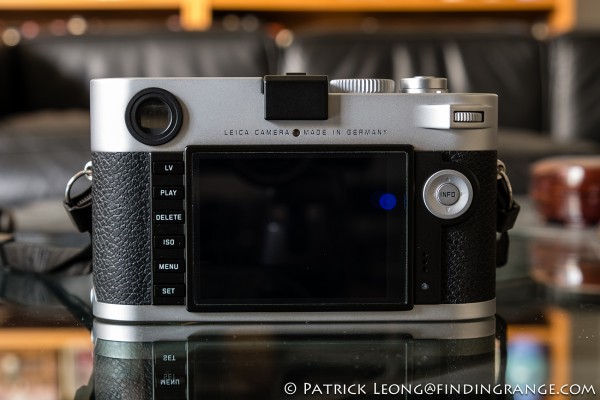
↑ Here’s a back view of the Leica M.
Side note: As of now, my Leica M is going back to Germany for the loose carrying strap eyelets issue. I haven’t experienced loose eyelets but mine is one of the serial numbers that has been recalled. While this is a mistake on Leica’s part, I stand by what I said in terms of the solidity of this camera. It’s one mistake, not the end of the world. There are many cameras out there who’ve been recalled before. At least Leica admits it, and will gladly fix it. If you get the chance to hold one of these in your hand, you’ll know what I mean; this is still the most solidly built camera I’ve ever owned.
UPDATE: Leica was kind enough to send me a replacement camera instead of fixing my old M.
Leica M Typ 240 Handling And Feel:
The first thing that I noticed was that the Leica M was actually slightly wider than the M9. For those keeping score, the M6 TTL was bigger than the older M6, the M8 was bigger than the M6TTL, and now the new M is bigger than the M9. This may worry some as one complaint about the M9 was that it was bigger than a Leica MP. I was a bit worried because I really like how the MP feels but in real world use, the camera actually feels nicer in the hand, and this is because of several small but key changes.
Buttons And controls:
First off, Leica finally put a small thumb rest on the new M. Looking at the publicity photos, I didn’t really expect this to make much of a difference but it does. The camera is very comfortable to hold even with the added weight. Plus, there is a scroll wheel built into the thumb rest, which is a really nice feature because it’s useful. Also, they moved the main scroll wheel up a bit, and made it smaller as well, so your palm isn’t always pushing against the scroll wheel like it was with the M8 and M9.
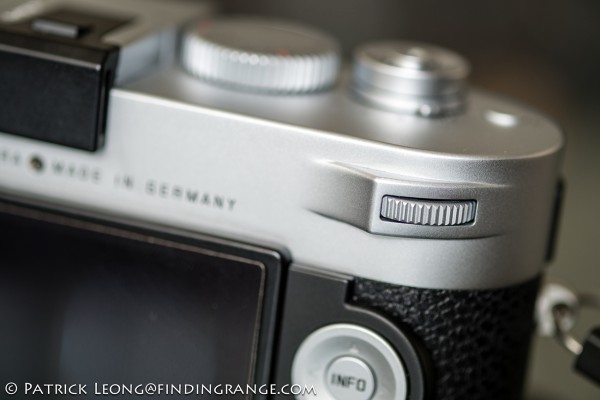
↑ The new thumb rest with a scroll wheel built into it.
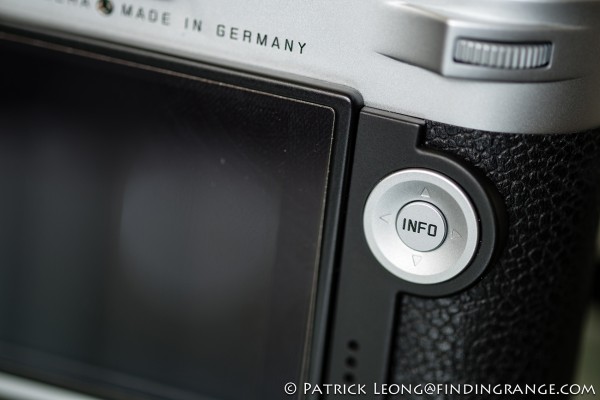
↑ The main scroll wheel is smaller and moved higher up on the body, making it much easier to hold the Leica M. I believe it’s metal as well.
The overall layout and controls are still very minimalistic, which is a definite plus. All the key controls that you need to worry about, like ISO, Playback, etc., are laid out in buttons, making it very easy to adjust important functions very quickly. Once you see the buttons and controls a couple of times, it becomes second nature to find them. The menu, while more complicated than the M9’s due to the new features, is still very straight forward, logical, and easy to get through. That’s one thing I always give Leica credit for; their menus are straight to the point. You don’t have to spend much time in them, and therefore, you can spend more time concentrating on taking more photographs. Picking this M up is just like picking up an M9; I honestly didn’t even have to read the manual. Plus none of the buttons or the scroll wheels gets in the way of your hands while you’re shooting. Sometimes with the Fuji X-E1, I end up pressing some of the buttons by accident but the button placement on the Leica M is excellent. When Leica went from the M8 to the M9, they essentially put M9 internals inside an M8 body. You can really tell that Leica not only improved on the internal electronics of the new M; they also definitely took their time figuring out the new layout and body for the M.
The New Shutter:
The control layout is not the only major change on the M Typ 240. The Leica M now has a very smooth and quiet shutter. I liked the M9 shutter but it sounds and feels a bit unrefined and clunky when compared to the new M’s. It doesn’t quite give you the same analog feel of a film M but it comes very close, and it’s probably the closest you’ll get for a digital camera. There is no discreet mode because you don’t need it anymore. It is simply a joy just to depress the shutter button because it’s so delicate, smooth, and quiet. This is how an M should be! It honestly makes me want to take more pictures :). Smooth shutter release has always been one of the hallmarks of Leica M cameras, and Leica has clearly done an excellent job in bringing that hallmark to the new M.
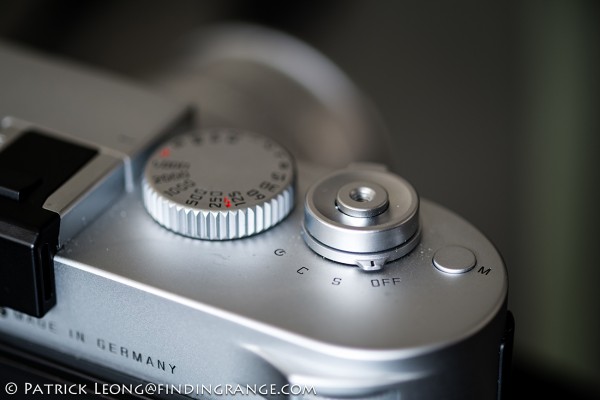
↑ The shutter on the Leica M feels completely different than the M9’s. Also, notice the “M” button? That’s nothing special; it’s just for movie mode :).
The New LCD Screen on The Leica M Typ 240:
Now, let’s talk about the LCD screen for a bit because one major complaint about the M9 was it cost $7,000 but came with an LCD screen that was, let’s just say, not up to par with it’s price tag. Let’s be honest; the D-Lux series had a better screen than the M9. As I stated before, the LCD screen is bigger than the M9’s, and the resolution is higher. It’s more accurate and useable than the one on the M9, which was pretty bad now that I think about it. True, I didn’t use the LCD screen much, and I still don’t use the M’s much either. But, for the $7,000 price tag, it’s nice to have a decent screen, and it’s nice to know that if I wanted to look at an image in more detail, I could.
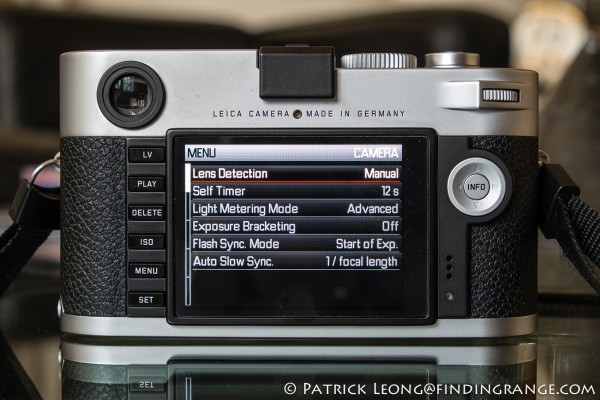
↑ The new larger, and higher resolution screen on the Leica M Typ 240.
The screen is not a completely revolutionary LCD screen that we’ve never seen before. But it is now on par with what should be expected in current camera technology, especially for a camera of this price. No longer do any M users have to deal with a screen that is several generations old. The new LCD screen is smooth, the colors are truer, and you can see a lot more detail than the one on the M9. Zooming with it is now smooth, without any lag. Not only is the new LCD good for reviewing pictures, it’s also perfect for many of the M’s new features.
The New Features of the Leica M Typ 240:
Yes, this M finally receives some new features beyond just taking great pictures. In fact, some of these new features on the Leica M might be considered as pure blasphemy to purists :). Coming out with new features in general for any M is a hard task for Leica because many loyalists (including me) love the way the camera is already. Quite frankly, there really isn’t anything quite like an M camera, and I don’t want anything to take away from the purity of it. That’s how I feel. It’s pretty much the only digital camera that I can think of whose strengths lie in its simplicity, and it’s one of the biggest reasons for coughing up $7,000. When I heard about some of these new features, I was thinking to myself, “what are they doing to my M???” I want my M to shoot great images, and that’s pretty much it. But do these new features really ruin the Typ 240? Let’s go over the list of new features and find out.
LED Lit Framelines:
One major change is that the Leica M inherits the LED lit framelines from the M9 Titanium. This change surprised me because it felt a little too “electronic” to put into an M. You can even choose between red or white, and they dim or brighten automatically based on the lighting conditions you’re shooting in. The framelines are also a lot more accurate than before, and the accuracy is quite noticeable as well.
Now here’s the thing; the Leica purist in me rejects these new framelines :). I know this sounds crazy but I really like the mechanical feel of the Leica M’s. But I must admit that these new LED lit framelines function very well. Now, I don’t think that these LED lit framelines are a necessity because I don’t feel like I had any problems with the old framelines in previous M’s. I never had an issue with them in well lit or dark conditions. But these new framelines are not a bad thing because they really work. In terms of the colors, I prefer the white color over the red. I feel that the red is almost gimmicky because I can’t really see the framelines that well in darker conditions. Red is supposed to be easier on the eyes but it’s not as if the white color is especially blinding.
Three Types of Metering Modes:
Another huge change for M users is that for the first time on an M, you can now choose from three different metering modes: classic or center-weighted, multi-field, and spot metering. This is another new feature that surprised me but I was pretty happy hearing about this. I’ve been trying out the multi-field metering a bit, and I really like it even though Leica’s instruction manual said that there might be some occasional lag. I’ve been using this camera for almost a month, and I honestly haven’t experienced any lag. Spot is also great too. I tried it on a couple of portraits, and it works pretty well. Whatever you decide, the metering ability has definitely gotten better with the Leica M.
The Larger Battery:
To run all of these new electronics, Leica naturally decided to replace the M9 battery with a much bigger one. Yes, this means that if you own an M8 or M9, then you’ll need to buy new batteries for the Leica M, and it’ll probably cost an arm and a leg But the great news is that this new battery lasts forever. I use to carry only two batteries with me for my M9. Now, I’m considering whether or not I should even buy a spare because this battery lasts so much longer than the older M9 battery. I’ll probably buy one when they become available only because it’s a good idea to have an extra.

↑ The new bigger battery.
Live View:
One of the biggest changes Leica has made with the new M is to put in live view. Some love it, some hate it. But wherever you stand, if you’re planning on purchasing the Leica M, you’re going to get live view. Is this bad? Does it take away from the purity of the M? In all honesty, I didn’t feel like I needed it until I did some shooting with a Noctilux that was on loan to me. I couldn’t get the Noctilux to focus at F1 correctly but live view (along with focus peaking) definitely helped. It also works very smoothly with no problems.
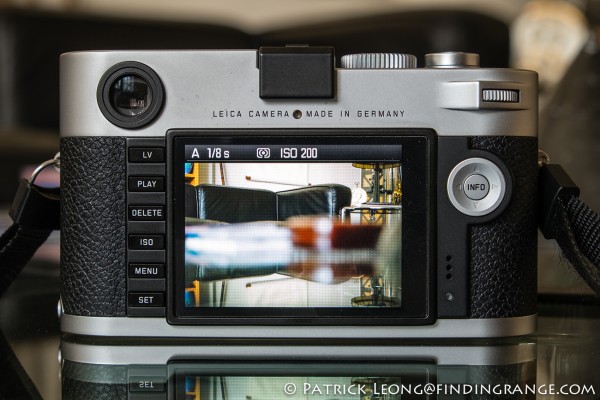
↑ A Leica M camera finally gets live view.
Overall, I prefer to use the rangefinder to focus, and I use it nearly 100% of the time because that’s what I bought the camera for. But that doesn’t mean it’s bad at all to have live view. I think it’s great that Leica decided to put live view into the new M. It doesn’t take anything away from the camera, and if you don’t like it, just don’t use it. Simply depress the LV button, and it will never come on. If you don’t turn it on, the Leica M will function just like an M8, or M9. There is absolutely no difference. But if you do give live view a chance, it will open you up to new opportunities that have never been experience by any other M camera.
New Live View Opportunities For The Leica M 240 – Movie Mode, Focus Peaking, R Lens Compatibility:
There are several new opportunities that M users can now take advantage of. For instance, we can now use all those wonderful M lenses on a full framed M camera in movie mode. Who would’ve thought an M would have movie mode (because I sure didn’t lol). But it does, and it works! It might not be the best video capable camera out there but in my opinion, you don’t buy an M for video. But again, it is a nice feature to have, and I bet a lot of people will have fun with it. And why shouldn’t they? Imagine all the cool videos that you could make with fast glass like the Noctilux?
Another great thing about live view is along with the new EVF, it allows you to use focus peaking to help you focus. I tried it a few times, and it’s pretty cool. This is a great help, especially for people with really fast glass, such as a Noctilux. With both the live view, and the EVF, you can also change the current zoom factor (choice of 5x or 10x) to really get precise focusing. For purists out there, just don’t use these features if you don’t like them. It does not take away anything from the Leica M. I still prefer to use the RF because that’s why I bought the Leica. But it’s great that Leica has incorporated these features in the new M for those who want them.
Lastly, thanks to live view and the EVF, most of those wonderful R-lenses can be used on the new M. Leica did not come out with a digital R camera but at least they made the Leica M compatible with R lenses. I think this is so cool but unfortunately, I have no R lenses. No longer is the M restricted to the primary fixed focal lengths; I can now use something longer than say, a 90mm. I can even use a zoom if I wanted to. I believe this opens the M up to completely new possibilities, and I’m tempted to buy some R lenses in the future to test them out.
Image Quality From The Leica M Typ 240 CCD vs. CMOS:
The Leica M is built better, and it has plenty of new features yet none of these features take anything away from it. But the big question is, how’s image quality? Well, there seems to be a huge debate going on about this because Leica switched from CCD to CMOS. I said this before the M was released: I am confident that Leica is not going to release a new flagship M that’s inferior, especially in image quality, to its predecessor. The M is arguably the most famous Leica camera line out there, so Leica is going to really think and do their research before they release a new M. Well, I can say from using the M9 since it’s release, and now using the new M exclusively for about a month that the Leica M is better in every way. Believe this fact or not but I know that I’m not the only user preaching this.

↑ The Leica M produces images that are great to convert into black and white. This was shot at 400 ISO with my 50 Summicron.
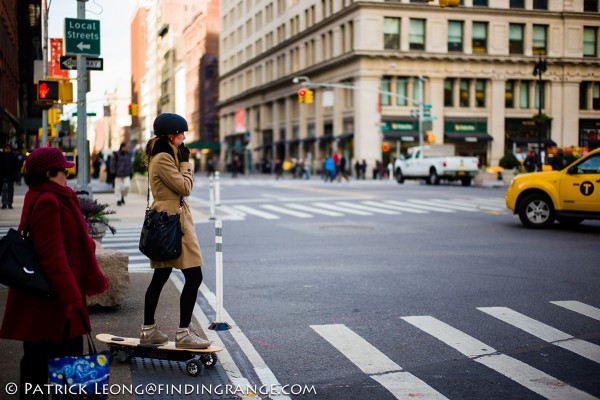
↑ This was taken with my 50 Summilux ASPH.
With it’s new 24 megapixel CMOS sensor, the new M produces files that are absolutely stunning. I feel image quality is not just simply an upgrade from what you can get from the M9 but several orders of magnitude better. I have not seen anything this good coming out of any other full frame camera. Of course, this is a matter of personal taste, and everyone has their own, but I’d being lying to all of you if I said otherwise. These files are fantastic, and quite frankly, give me goosebumps. I think there are many who are in a way hoping that this M isn’t as good as the M9, but I believe in giving everything a REAL chance. A real chance means you have to experience something hands ons for yourself, and arrive at a judgement free of biases. Some are saying that you can’t use DXOMark to judge what the M9 can truly produce, and I believe that as well yet how can we judge a camera based purely on the fact that it uses a CMOS sensor instead of a CCD?
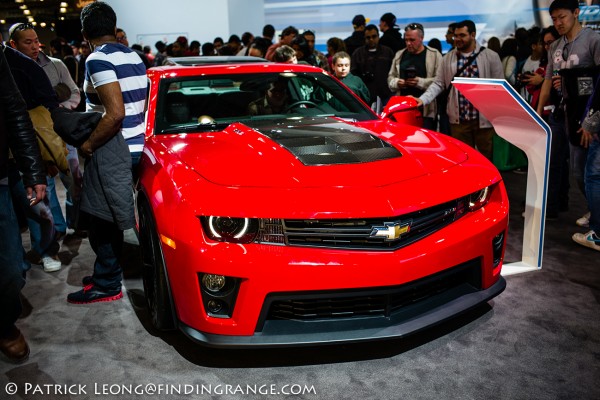
↑ The Leica M is great with reds. It’s creamy and rich yet it still is tack sharp. This was shot with the 35 Summicron ASPH at 800 ISO.
Are the images different than what comes out of the M9? Sure they are. But different doesn’t mean worse. Think about it; if CMOS is the wave of the future for Leica, does that mean the M9 is the best digital M that will ever come out from Solms? Does this mean that Leica reached the pinnacle of M digital perfection with the M9? I don’t believe that.

↑ The new Leica M is plenty sharp. This was shot with the 35 Summicron ASPH at 200 ISO.
The files from the new M are richer, smoother, more vivid, and bitingly sharp. They’re more flexible as well. The files are very three-dimensional, and the auto white balance is pretty decent. Some are saying that the files from the Leica M just don’t have the same pop or detail as what came from the M9. I have two things to say about that: First off, I completely disagree. Second, get off the CCD vs. CMOS issue lol! This camera is excellent, and if this is what I can get out of a Leica M with a CMOS sensor, than sign me up for future CMOS M’s!
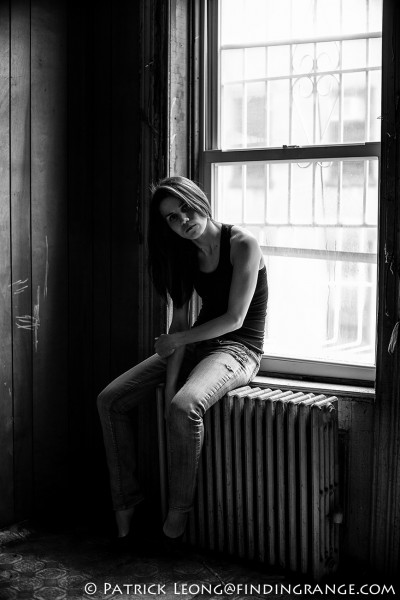
↑ This image was shot with the Noctilux at 200 ISO.
↑ Beautiful day at Central Park. This was shot with my 35 Summicron ASPH.
↑ Here is another photo with my Leica M and 50 Summilux ASPH. The bokeh is great yet the subject is tack sharp.
I absolutely loved the CCD sensor in the M9. I thought it was one of the best characteristics of the M9 because the sensor along with Leica’s fabulous lenses really gave the M9 its character. But I am getting better files out of the Leica M, and while the character is different, I actually prefer it. The files are a lot smoother than the M9 files, and I think sometimes it may seem that a bit of detail is lost, especially when people are generally looking at online examples right now. On the contrary, the files are even more detailed, and have more pop. Subjects pop out of the picture even when shot at very small apertures. Colors in photos just pop like no other files that I’ve ever seen before, and the great thing about this is that you don’t need much work at all to get great looking files. Most of the files here took maybe a minute or two in Camera Raw. The pictures here have to be resized, and are compressed but full size, uncompressed images are simply breathtaking. There is no other word for them. Try printing some, you’ll see what I mean. I have no doubt that we will see even better examples of what the Leica M can do once more people get their hands on one, and once people get acclimated to working with the new files. I feel that the DNG files need to be worked on a bit differently but that goes the same for all cameras. I don’t work on my Fuji files in the same way that I work on my M9 files. Once you get use to working with the new M files, you will be very, VERY pleasantly surprised at what you can get, especially with the increased dynamic range.

↑ This was shot with the 50 Summilux ASPH. Even at F5.6, there is plenty of “pop”.
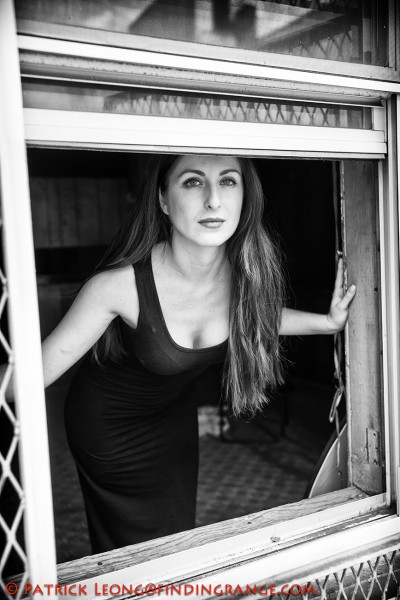
↑ I took this with the Leica M and 35 Summicron ASPH combo.
↑ I took this with the Leica 18mm Super Elmar F3.8.
↑ 50 Summilux ASPH.

↑ This was taken with my 35 Summicron ASPH.
↑ 50 Summicron at 400 ISO.
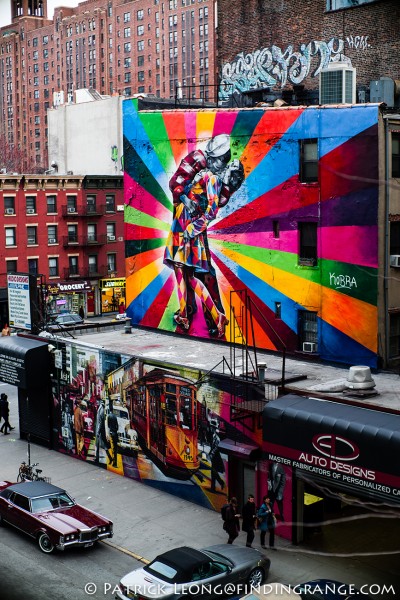
↑ This photo was taken with the Leica M and Noctilux combo.
Another important thing I should mention: the colors actually look more realistic from the new M when compared to the M9. I’ve been hanging around my camera dealer (Bergen County Camera) ever since I bought my M, and I’ve been seeing a lot of examples sent to them from other happy M 240 customers with similar conclusions.

↑ Here’s a photo taken with the Noctilux at F1. I have this lens on loan from Bergen County Camera, and all I have to say is that this lens is awesome minus the learning curve in terms of focusing.

↑ Here’s another photo with the Noctilux at F1.
↑ I took this with the Leica M and 35 Summicron ASPH combo.
↑ Leica M and 50 Summilux ASPH combo.
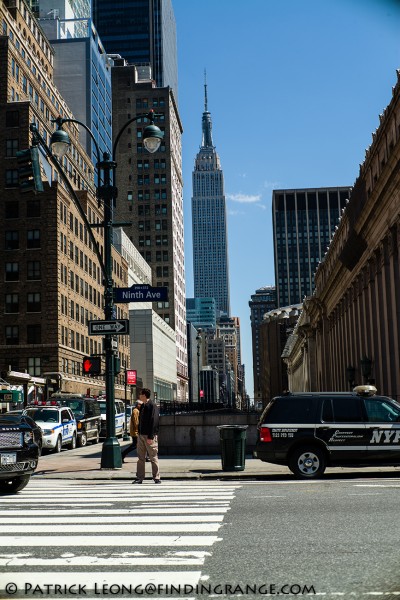
↑ I know everyone loves using the Noctilux wide open but it’s also a great lens when you close it down a bit. It’s just a little heavy to carry all day ;).
High ISO With The Leica M Typ 240:
The M9 performed excellently at lower ISO’s but it just didn’t quite cut it at higher speeds. However, I was completely content with the quality I was getting from the M9 at lower ISO speeds, so I didn’t care as much about high ISO capability, especially since I had fast lenses. I’m happy to say that this M does not suffer from the same fate. No longer do you need to perform any “tricks” or adjustments to make high ISO images look better. I mean, you could if you want but I’m very happy with the results that I’m getting. Just as with the M9, I don’t usually shoot higher than 1250 ISO but it’s really nice to know that you can shoot a lot higher if you wanted to. The high ISO images coming out of the Leica M are up there with some of the best that I’ve seen. It really is such a big difference from the M9. With this camera, you have a lot more freedom to crank up the ISO if you need it, and that’s how it should be with today’s cameras. There is slight loss of dynamic range as you increase the ISO but you can easily shoot at 3200 ISO or even 6400 ISO if required. The results are great.

I took this photo with the 75 Summilux at 1600 ISO.

↑ Here’s a shot taken at 3200 ISO with the Noctilux at F1. The only light source was a yellowish street light.
The CMOS sensor has definitely helped out again in the new M. The digital M’s weren’t famous for high ISO capability but I think that’s about to change, starting with the M 240. In the M8/M9 days, people relied on fast Leica glass to compensate for ISO performance but now with the Leica M, you have both fast Leica glass, and high ISO capability. In other words, you don’t have to shoot everything wide open in dark conditions if you don’t want to anymore.

↑ I was in the passenger seat of my car, and took this quick snap at 3200 ISO with the 35 Summicron wide open.
The Pros and Cons of The Leica M Typ 240:
Pros:
- Incredible build quality – in my opinion, the best built M.
- The thumb rest is a great feature.
- Weather sealed.
- Buttons, controls, and layout much improved over the M9.
- Camera is much more comfortable to hold.
- Great LCD screen with no lag.
- The new shutter is very smooth, and has a feel similar to the film M bodies.
- LED lit framelines, which are actually more accurate as well.
- Three metering modes now.
- Battery lasts much longer.
- Live view.
- Movie mode.
- Focus peaking capability – tried it with the Noctilux, and it works great.
- Can use most existing M lenses, and now R lenses as well.
- Image quality is FANTASTIC.
- Dynamic range is great.
- High ISO is now up there with some of the best.
- New CMOS sensor is incredible.
- EVF capable.
- Price has not increased from the M9 but actually dropped $45.
- A list of new features but in no way takes away any of the purity of the M – still feels like a true M in EVERY WAY.
- Speed improvements over the M9 thanks to the Maestro chip.
- The Leica M feels several generations better than the M9.
Cons:
- The Leica M is a bit thicker than previous digital M’s.
- Movie mode is good and fun but not up to what a professional would require.
- Still expensive.
- Accessories are expensive.
- Short delay during start up.
Leica M Typ 240 Closing Thoughts:
I hope this user review gives you an idea of what the new Leica M is all about. For me, this is not the conclusion of my Leica M 240 review but just the end of chapter one. I received my camera on March 28th, so I only had this camera for about a month. Essentially, I want this review to continue as an overall user experience. Therefore, I plan on continuing this review by adding to it periodically, so please stay tuned.

↑ I really love the fact that you can still use older Leica lenses, such as, the Noctilux F1 on the Leica M.
I guess the biggest question I’ve been asked so far about the new Leica M is: Do I regret selling my M9? The M9 was, and still is an amazing camera. Some may not think so but users including me know it is. Sure, it has it’s bugs. I experienced calibration issues, and a cracked sensor (which Leica replaced free even though my camera was out of warranty) but what camera doesn’t have its issues? Fuji had orbing problems, Nikon had sensor issues, and the list goes on and on. But even with the M9 being such an excellent camera, I can say without flinching that I have no regrets selling it.
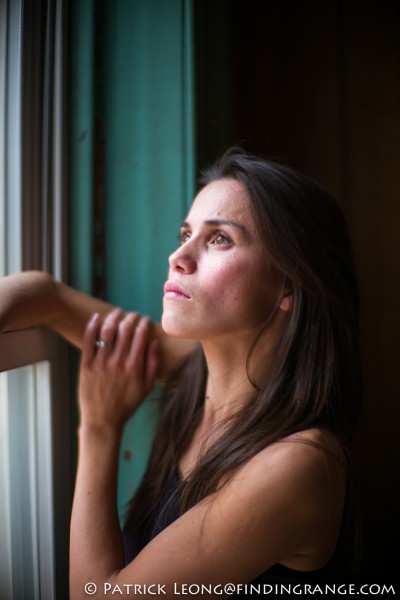
↑ Another shot with the Noctilux at F1.
The new M’s refinements make this camera even more capable and user friendly than the M9 ever was; yet it doesn’t lose any of the analog feel that the M9 or any M has. Why? Because if you’re a purist, and you don’t want to use any of the new features, you don’t have to. It’s as simple as that. If you don’t use them, the Leica M performs just like an M9. But there are several added bonues: the new M does feel like it’s several generations beyond the M9 in image quality, build quality, electronics, and overall usability while still retaining the magic and purity of older Ms.

↑ Noctilux at F1 with the Leica M.
↑ 18mm Super Elmar.
↑ Here’s a shot with my favorite lens: the 50 Summilux ASPH.

↑ I guess the big Noctilux caught the attention of this little girl :).
↑ Leica M with the 18mm Super Elmar.
For me, the analog feel of Leica M’s is what I deem most important. I love looking through my optical viewfinder, composing with the framelines, and adjusting all of my settings manually. I love the bare bones feel that I get from the Leica M cameras, and it’s the reason why I still buy Leica’s after all these years. I feel I’m actively involved in the photographic process, and in my opinion, this is what any M does best. It makes me truly enjoy, and love the shooting experience. It’s kind of like electronic assisted power steering in cars these days. Sure, they allow more flexiblity in terms of personalizing the feel, and they help with gas mileage but there’s a reason why a lot of car magazines who test these cars miss the older steering. The older designs just have a more tactile, and satisfying feel than electric power steering. It can send messages from the road better than electronic power steering can, and the steering doesn’t feel as dead. The M cameras are similar to this because when you photograph with one, you get that same raw analog feel that I’m sorry to say, is missing from cameras these days. Yes, this analog feel comes with a price, and I don’t just mean financially; you’re constantly thinking, and making adjustments in your brain, and you always have to think a head but for me, that’s the fun part. I want to be fully involved in anything that I do, especially something I enjoy as much as photography. I want to have full control of my camera. A camera does not make you a better photographer but it sure can make you enjoy photography a bit more, and help you take a more active role in it. I don’t have to scroll through the menu to adjust everything because the main functions are manually adjusted on the M. In fact, you spend very little time in the menu, and in that way, it also reminds me of using a film camera. Sure, there are many great cameras out there that have excellent image quality, and I’m not debating that. Plus, an M is not a camera for everyone. But for me, I just can’t find another camera that feels like an M. Nothing else has that Leica feel. The Leica M brings back the same feelings I felt when I was shooting with my old M3: it makes me find the dumbest reasons just to take it out, and shoot with it. I’m addicted to the new M just like I was with my previous M’s if not more so. For me, that’s well worth the $7,000 price tag.
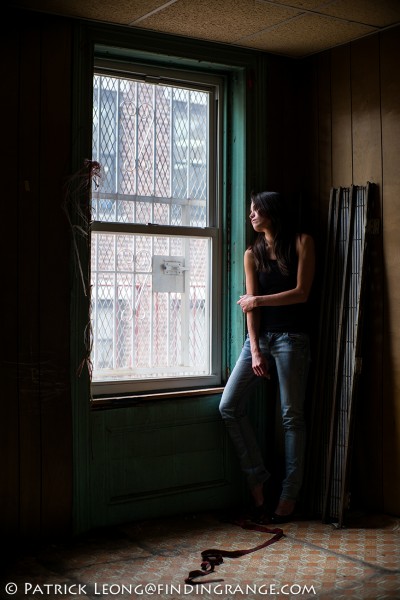
↑ I shot this photo at F2.8 if I remember correctly with the Noctilux.
↑ 18mm Super Elmar.
↑ Here’s one more with the 50 Summilux ASPH.
Sometimes a classic like the M needs to be reinvented. Reinvention does not necessarily mean a complete redesign, and the loss of the original signature. It can mean reinterpreting a classic for a new age. Porsche did this a few times with their iconic 911, and the 911 is better for it. The Leica M has a list of new features, such as LED lit framelines, movie mode, live view, R lens compatibility, and the biggest controversial change being the new CMOS sensor but in no way do any of these new changes take away the essence of what an M is. The M soul is still there, if not refreshed, refined, reinvigorated, more lively, and ready for the 21st century. I really believe that Leica finally got the M digital right. I said this in the beginning of this review, and I will say it again: the Leica M is my favorite M camera. I know all of this sounds a little too passionate for a device whose only purpose is to take photographs but I can’t help myself; I’ve been a loyal Leica fan and user for many years, and the new M really is something special. Plus, if you’re on a photo blog reading about cameras like the new M, I assume you share the same passion as me.

If you’re considering buying the Leica M Typ 240, and my review helped you decide, please help support me by purchasing from one of the links below. Thank you for your support!
Leica M from Amazon
Leica M from Adorama
Bergen County Camera – I don’t get anything from them but BCC offers the best personal service. People end up being loyal customers for life. My family and I have been buying from BCC for 30 years. Ask for Bob (Westwood store). He co-owns the business with his brother. They also have a great selection of used Leica stuff.
Leica M Typ 240 Review




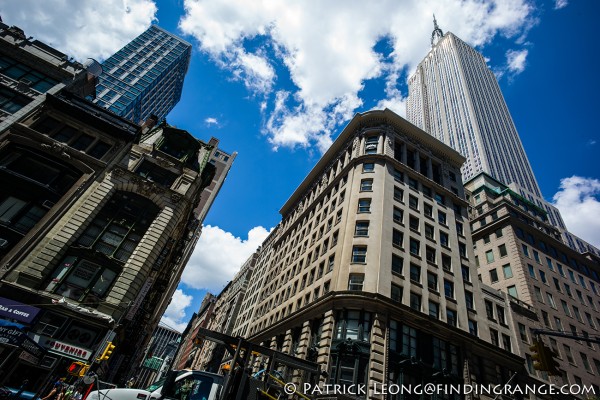

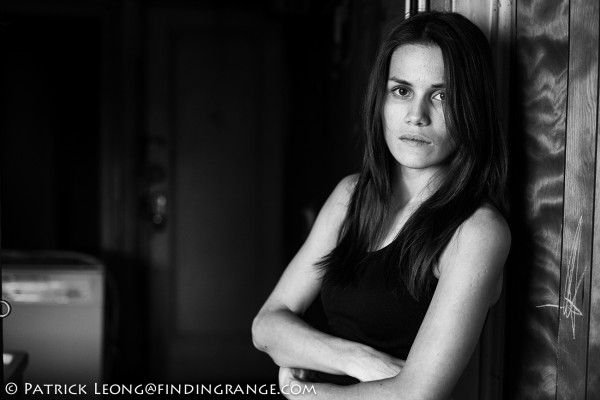




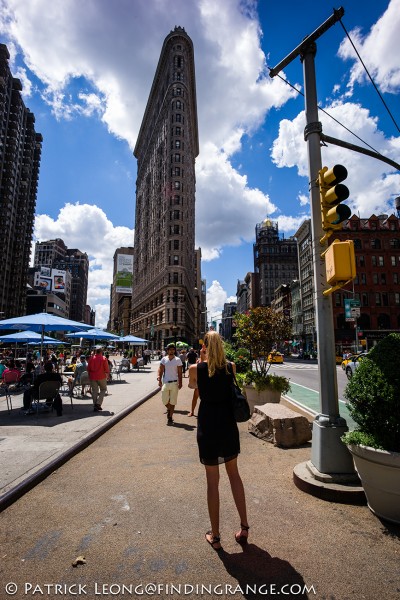


Hello Patrick, thanks for the review. They are mostly what I had read and I have to agree with you on your assessment. I had played with it for a while at Leica Store, too. The only thing is really if I will choose to give up M9-P for M240. I love CCD images and the combination of Leica lens & M9 is awesome. The only complaint is high ISO ability. The M240 images to me is a little DSLR like. In earlier images on the Internet, they are a little flat. Now as more people are showing M240 images, they are closer to M9’s. may be they are after some post production. The signature and foot print are different. While I like the operation and improvements of M240, it is now a matter of choice and money.
Best regards,
Michael.
Hi Michael,
Thanks for your comment! The M9 is still a terrific camera, and I can completely understand your feelings. It was hard for me to part with mine. In my opinion, the M9 at lower ISO speeds, is still a very hard camera to beat in terms of image quality. Whatever you end up deciding to do, at least you’ll know you will end up with a great camera :). Nice hearing from you again, Michael,
Take care,
Patrick
A comprehensive, balanced and informative review. I agree with your assessment of CMOS as trumping the older technology; even if CCD-ers find it hard to let go. Your photos, as usual, are first-rate.
Thanks for your comment, and I’m glad you liked it! Thanks for stopping by!
Hi Patrick;
thank you for your great review; very informative and helpful. And with very nice pics too.
I have three questions:
– How would you describe the difference between the new M and the X-Pro 1 in terms of image quality
a) of the raw-files and
b) of the out of the camera jpgs?
– What’s about the M’s AWB? There are a lot of discussions in the internetcommunity around this question. Most of the owners are writing about a AWB, which is very often inaccurate and too warm.
Best regards from Cologne (Germany)
Niklas
Hi Niklas,
Thank you for your comment, and I’m glad you enjoyed my review! To answer your questions:
First off, I process pretty much all my stuff in RAW but I do shoot in both Jpeg and RAW. This is what I think:
a) RAW – RAW files are a lot more flexible with the M. It’s not like you need it though because it really doesn’t take much work to produce a nice file. Did you see that red Camaro photo in my review? That red is amazing, and it’s actually the way that I remember it but I really didn’t do much to bring that red out. Colors are truer to the original scene, and more realistic (this goes for the jpegs as well).
b) Jpeg – Fuji jpegs have always been great but I much prefer the M’s. This is quite surprising to me because the M9’s were not nearly as good. When I put my name down for a pre-order, I was not expecting amazing jpegs to come out of the M but I am quite pleasantly surprised. Obviously, you get the detail, better dynamic range but more importantly, the colors and tones are more faithful to the scene. The images and the color just look more realistic. I mentioned detail was better but it’s not just the micro detail that I’m talking about. The camera really picks up on the subtle tones, and all the other subtleties of the overall scene. You also get a really nice three-dimensional pop and depth in your photos. The biggest thing for me is that the files don’t have such a digital feel to them. There’s also this smoothness/creaminess you get similar to medium format. There are so many new improvements yet nothing is overly exaggerated.
M’s AWB:
I don’t know what anyone else is saying about the AWB (except for a couple of other reviews that I’ve read) but I find the AWB on the M much more accurate than with the M9. I’m quite surprised at how good it is. In fact, in some cases, I find it more accurate than the Fuji’s. I know what you’re talking about in terms of AWB sometimes being too warm, and in some cases the AWB on the M is wrong (but what camera doesn’t miss occasionally) but overall, it’s MUCH better than it ever was on the M9.
General Notes:
I have nothing against the Fuji. How could I, when my site is full of Fuji stuff lol. Plus, I have no desire to sell the Fuji because quite frankly, it’s a great camera. But the files on the new M are simply fantastic. It’s more than I ever expected. If you wanted to, I’m sure you could just use the jpegs right out of the camera. The reviews that I’ve read were very positive in general, and I have to agree wholeheartedly. I really feel I got my money’s worth, and that’s not a common occurrence these days. I’m planning on continuing the M review once it gets back from Germany. I’ll probably talk about the in-camera black and white jpegs next. Please come back, and check it out.
I hope I answered your questions. Thanks for taking the time out to read my review,
All the best,
Patrick
I enjoyed your commentary on the new Leica M, it was easy to read and your descriptions were not too technical. It enabled this senior citizen to understand and hope to buy one, thanks. Stan
Hi Stan,
Thank you for your kind words! I’m very glad that you enjoyed it! Hope to see you around here again,
Patrick
I was just wondering if you seeing much dust on your sensor?
I have only had my M 240 for three days. In which time I have changed lenses (indoors only) maybe six times. Already I have more dust on my sensor than any other camera I have ever owned.I was just wondering after a month, how your sensor was looking?
Hi Adam,
Thanks for your comment. I have some dust on my sensor but after a month of use, it’s still nothing significant. Nothing I needed to clean. Nice photos btw :).
Patrick
What an Amazing job on the Review! You explained I think the true Leica owners love of photography and explained the camera in a quite detailed and useful way . I just wanted to let you know the chairman and majority owner of Leica posted the link to your blog on his FB page so he really must have enjoyed it as well. Thanks Pat for carrying the torch and showing your terrific images to the outside world who dont know the joys of owning a Leica. You worked very hard to get your first one and really appreciate what it takes to make a fine instrument and what wonderful images it can produce in the right hands
Hi Bob!
Thanks for reading it, and I’m glad you enjoyed it! Wow, that is the coolest news I’ve heard in quite some time! I still can’t believe he checked it out! I’m really looking forward to coming to your Leica Boutique opening. I can’t wait, and thanks for inviting me! Thank for all your support throughout the years! See you soon!
Pat
Great review. I’ve been on/off with the M and was thinking of cancelling my order and keeping my M9. You have helped me swing back. I’m gonna sit and wait my turn and hopefully will have one by the end of the year.
Hi Dannybuoy,
Thanks for the kind words, and for taking the time out to read my review! Yeah, I think you’ll be really please with the new M. I loved my M9 but I really feel that the refinements in the M 240 make it worth upgrading. I have absolutely no regrets. Plus, if you think about it, while it’s still expensive, Leica actually reduced the price of the new camera. I hope you get yours early but however long it takes, it’ll be well worth the wait! Take care!
Patrick
Patrick, great review! Can I ask which SD card brand, size, and speed you’re using? I’m about to take delivery of an M240 and need to buy a faster SD card for it as I’ve been using slow cards in the past with the M9.
Hi Christian,
Thanks for the kind words! Nice photos on your website! As for SD cards, Leica states, “we recommend the use of Class 10 cards with speeds of ≥30 MB/s – e.g. from the SanDisk Ultra or SanDisk Extreme lines. SDXC cards with higher speeds are compatible, but offer no additional benefit in terms of speed compared with SDHC cards.” So, as long as the SD card fits that criteria, and is a legitimate name brand (my preference has always been Sandisk), I’ll buy it. Quite frankly, I look at the ones that are on sale :).
For instance, I actually bought 32gb and 64gb Sandisk Extremes 60mb/s cards for my recent Japan trip and they worked great. At the time, I paid like $20 for the 32gb and $40 for the 64gb. I’ve used every size of card in the M 240 except for a 128gb and 256gb card and have had no issues. I’ve actually never lost a photo from a corrupted card (knock on wood), so I usually go for larger cards because the files on the M 240 are quite big, especially if you plan on shooting both raw and jpeg.
What else? As I said before, just make sure it’s a decent name brand. I used to use cards from Lexar, PNY, Sandisk, and Transcend in my M9 but I pretty much just stick with Sandisk cards in my M240. All those other companies make decent products but I’ve just had great experiences with Sandisk cards, so I stick with them. I just find their products in general (thumb drives, etc.) very reliable, and nowadays, all SD cards are so cheap that Sandisk SD cards, don’t cost significantly more than their competitors. Also, I’ve tried a slower card from my M9 days, and it does not work too well.
I hope that helps and let me know how you like your new M 240 when you had the chance to test it out! If you have any other questions, feel free to ask!
Best regards,
Patrick
P.S. I have faster cards than the ones I recently purchased but I don’t feel any difference.
If you haven’t used this, I suggest you give it a try. It may just make your M240 a little quicker.
https://www.sdcard.org/downloads/formatter_4/
Hi Chris,
Sorry for the late reply. Thanks for the info! I will take a look at it! Thanks for stopping by,
Best regards,
Patrick